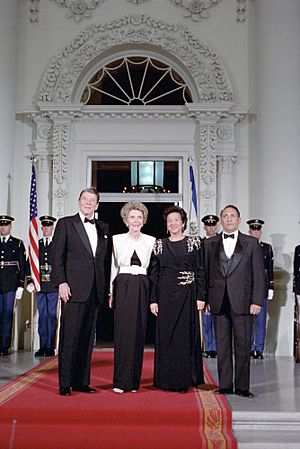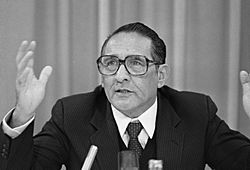José Napoleón Duarte facts for kids
Quick facts for kids
José Napoleón Duarte
|
|
|---|---|
 |
|
| 36th President of El Salvador | |
| In office 1 June 1984 – 1 June 1989 |
|
| Vice President | Rodolfo Castillo |
| Preceded by | Álvaro Magaña |
| Succeeded by | Alfredo Cristiani |
| President of the Revolutionary Government Junta | |
| In office 13 December 1980 – 2 May 1982 |
|
| Vice President | Jaime Abdul Gutiérrez |
| Preceded by | Position established (Jaime Abdul Gutiérrez as chairman) |
| Succeeded by | Position abolished (Álvaro Magaña as president of El Salvador) |
| Minister of Foreign Affairs | |
| In office 3 March 1980 – 1982 |
|
| Preceded by | Héctor Miguel Hirezi |
| Succeeded by | Fidel Chávez Mena |
| Mayor of San Salvador | |
| In office March 1964 – 1970 |
|
| Succeeded by | Carlos Rebollo |
| Personal details | |
| Born |
José Napoléon Duarte Fuentes
23 November 1925 Santa Ana, El Salvador |
| Died | 23 February 1990 (aged 64) San Salvador, El Salvador |
| Cause of death | Stomach cancer |
| Resting place | Cementerio Jardines del Recuerdo San Salvador, El Salvador |
| Political party | Christian Democratic Party |
| Spouse | Inés Durán de Duarte (died 2011) |
| Education | Liceo Salvadoreño |
| Alma mater |
|
José Napoleón Duarte Fuentes (born November 23, 1925 – died February 23, 1990) was an important politician from El Salvador. He served as the President of El Salvador from 1984 to 1989. Before becoming president, he was the mayor of San Salvador.
He first ran for president in 1972 but lost. Many people believed that election was not fair. After a military takeover in 1979, Duarte led a group called the Revolutionary Government Junta from 1980 to 1982. He was then elected president in 1984. His time as president happened during the Salvadoran Civil War.
Contents
Early Life and Education
Duarte was born in Santa Ana, El Salvador. In May 1944, while he was a student, he joined protests against the government. These protests helped remove the president at that time.
Later, in 1945, he went to Guatemala to join others who were against the government. Even though he didn't speak English, his father sent him to the University of Notre Dame in the United States. He worked hard, washing dishes and doing laundry, to pay for his studies. In 1948, he earned a degree in engineering.
After graduating, he returned to El Salvador. He married his childhood sweetheart, Maria Inés Durán. They had six children together. Duarte worked in his father-in-law's construction company and also taught classes.
Political Journey
Starting the Christian Democratic Party
In 1960, Duarte helped start the Christian Democratic Party (PDC). He became its Secretary General. This party aimed to find a middle path between extreme political groups.
Serving as Mayor of San Salvador
In March 1964, Duarte became the Mayor of San Salvador. He started evening schools for adults to help workers get technical skills and high school diplomas. He also supported new parts of the economy. Duarte was very popular and easily won re-election as mayor in 1966 and 1968. He left office in 1970.
Presidential Election of 1972
In 1972, Duarte ran for president. He was part of a group called the United National Opposition. He lost the election to Arturo Armando Molina. However, many people believed the election results were false. They thought Duarte had actually won more votes.
After the election, some military officers who supported Duarte tried to take over the government in March 1972. This attempt failed, and Duarte was arrested. He was forced to leave the country and went to Venezuela. In Venezuela, he worked as an engineering advisor. He also helped with international Christian Democratic groups. He tried to return to El Salvador in 1974 but was sent back to Venezuela.
Leading the Junta

On October 15, 1979, a group called the Revolutionary Government Junta (JRG) took control of El Salvador. This event marked the start of the Salvadoran Civil War. Duarte returned to El Salvador on March 3, 1980, and joined the Junta. He became El Salvador's foreign minister.
In December 1980, Duarte became the head of the Junta. A rebel group called the Farabundo Martí National Liberation Front (FMLN) launched a big attack on the government in January 1981. This led to the United States sending military help and advisors to El Salvador.
During his time leading the JRG, Duarte started some important changes. He began land reform, which aimed to give land to more people. He also took control of some industries, like sugar. He spoke out against bad actions by both the military and the FMLN. However, despite his efforts, violence against civilians continued during this period.
President of El Salvador (1984–1989)
In the 1984 presidential elections, Duarte ran as the candidate for the Christian Democratic Party. He won the election in May, defeating Roberto D'Aubuisson. The elections had some violence near voting places.
Duarte became president on June 1, 1984. He wanted to end the civil war through talks, not fighting. On October 15, 1984, he met with FMLN leaders in La Palma. This meeting was a big step towards ending the war. He hoped the rebels would put down their weapons and rejoin society.
In 1985, Duarte tried to improve the government's image. He tried to stop the Salvadoran Air Force from bombing civilian areas without his permission. He also created a group to investigate political killings. However, it was hard to control all the violence.
In the 1985 elections for Congress, Duarte's party won more seats. This made it easier for him to achieve his goals.
Daughter's Abduction
On September 10, 1985, Duarte's daughter, Inés Guadalupe Duarte Durán, was kidnapped. Her friend, Ana Cecilia Villeda, was also taken. They were abducted by members of the FMLN.
Duarte's family was sent to the United States for safety. He then started talks to get his daughter and her friend released. After several weeks of secret talks, Inés Duarte and her friend were set free on October 24. In exchange, 22 political prisoners were released. Also, 25 mayors and local officials kidnapped by the FMLN were exchanged for 101 wounded rebel fighters. The Red Cross helped with this exchange.

The kidnapping of Duarte's daughter was widely criticized. Many people said it went against international rules.
Efforts for Peace
In 1986, Duarte's plans for tax reform were not approved. In August, he took part in the Esquipulas II agreement with other leaders. This agreement aimed to bring lasting peace to Central America. It planned for rebel groups in El Salvador, Guatemala, and Nicaragua to stop fighting.
On October 5, 1987, a third round of talks began between the government and the FMLN. A few weeks later, a law was passed to forgive certain crimes. This happened just after a human rights leader was killed. Some people saw this killing as a sign against the peace process.
Duarte was criticized for not fully investigating the human rights leader's death. He offered a reward for information and asked for an investigation. A suspect was arrested and confessed to being part of a rebel group.
As his presidency continued, Duarte faced many challenges. There were rumors of corruption and the economy was struggling. The civil war seemed to have no end. His government became less effective. In the 1988 elections, his party lost many seats in Congress.
In June 1988, Duarte was diagnosed with advanced stomach cancer. He was given a short time to live. Despite his illness, he refused to resign as president. He handed over power to Alfredo Cristiani in June 1989. José Napoleón Duarte passed away on February 23, 1990, at the age of 64.
Duarte: My Story
In his book about his life, Duarte wrote that his dream was to see El Salvador become a truly democratic country. He believed that when society's rules and values showed a democratic system, the changes he worked for would finally happen.
Images for kids
See also
 In Spanish: José Napoleón Duarte para niños
In Spanish: José Napoleón Duarte para niños




